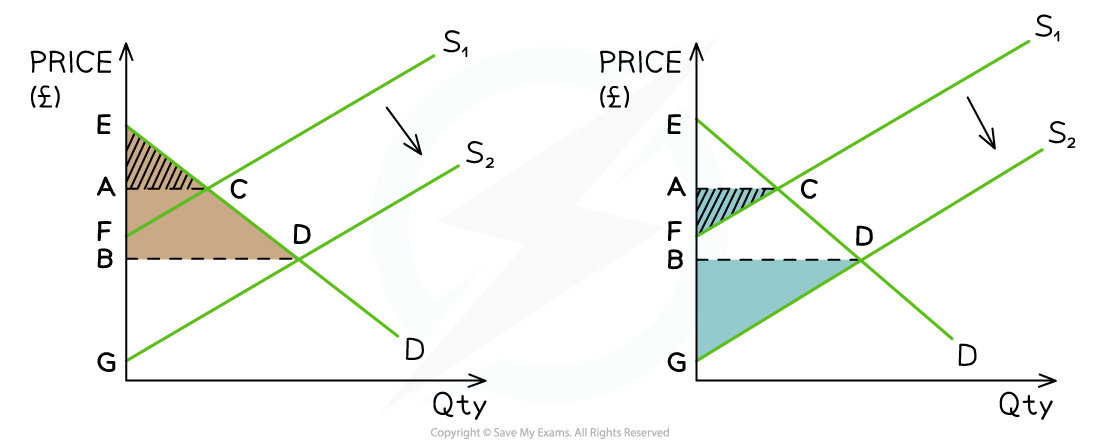Producer & Consumer Surplus (Edexcel A Level Economics A): Revision Note
Exam code: 9EC0
Producer & Consumer Surplus
Consumer surplus is the difference between the amount the consumer is willing to pay for a product and the price they have actually paid
For example, if a consumer is willing to pay £18 to watch a movie and the price is £15, their consumer surplus is £3
Producer surplus is the difference between the amount that the producer is willing to sell a product for and the price they actually receive
For example, if a producer is willing to sell a laptop for £450 and the price is £595, their producer surplus is £145

Diagram analysis
The area between the horizontal equilibrium price line and the demand curve represents the consumer surplus in the market (ABPe)
The consumer surplus lies underneath the demand curve
The area between the horizontal equilibrium price line and the supply curve represents the producer surplus in the market (CBPe)
Producer surplus lies above the supply curve
When the market is at equilibrium the producer and consumer surplus are maximised
Consumer surplus + producer surplus = social/community surplus
Any disequilibrium reduces the social surplus
How Market Changes Affect Producer & Consumer Surplus
Any change to the condition of supply or demand will cause a shift in the relevant curve
This shift will change the consumer and producer surplus in the market
An increase in supply

Diagram analysis
Prior to the change in the condition of supply
Consumer surplus was equivalent to ACE and producer surplus was equivalent to ACF
Social surplus was equivalent to ECF
After the change, supply increased S1→S2
Consumer surplus was equivalent to BED and producer surplus was equivalent to BDG
Social surplus was equivalent to DEG
Both the consumer surplus and producer surplus have increased as a result of the increased supply in the market
An increase in demand

Diagram analysis
Prior to the change in the condition of demand
Producer surplus was equivalent to ACE and consumer surplus was equivalent to ACF
Social surplus was equivalent to ECF
After the change, demand increased D1→D2
Producer surplus was equivalent to BED and consumer surplus was equivalent to BDG
Social surplus was equivalent to DEG
Both the producer surplus and consumer surplus have increased as a result of the increased demand in the market
Examiner Tips and Tricks
MCQ frequently tests your ability to identify changes to consumer and producer surplus. In essay responses, even if it is not explicitly mentioned, you can refer to these concepts when evaluating dynamic markets and the impacts on different stakeholders. It demonstrates excellent economic knowledge and analysis.
Changes to consumer and producer surplus become slightly more complicated when analysing the impact of government intervention such as indirect taxes, subsidies and price controls.

Unlock more, it's free!
Did this page help you?